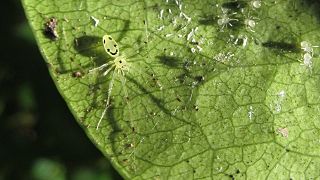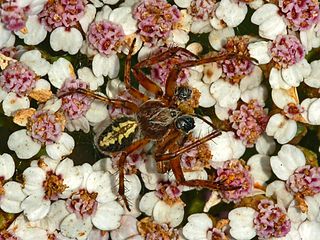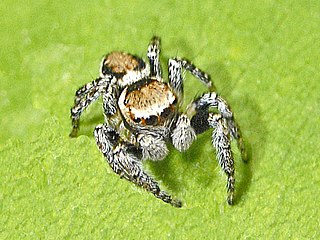
Velvet spiders are a small group of spiders almost entirely limited to the Old World, with exception of a few species known from Brazil. In Europe some are commonly called the ladybird spiders

The katipō is an endangered species of spider native to New Zealand. It is one of many species in the genus Latrodectus, such as the Australian redback, and the North American black widow. The species is venomous to humans, capable of delivering a potentially dangerous bite. It is a small to medium-sized spider, with the female having a round black or brown pea-sized body. Red katipō females found in the South Island and the lower half of the North Island, are always black, and their abdomen has a distinctive red stripe bordered in white. In black katipō females found in the upper half of the North Island, this stripe is absent, pale, yellow, or replaced with cream-coloured blotches. These two forms were previously thought to be separate species. The male is much smaller than the female and quite different in appearance: white with black stripes and red diamond-shaped markings. Katipō are mainly found living in sand dunes close to the seashore. They are found throughout most of coastal New Zealand except the far south and west. Katipō feed mainly on ground dwelling insects, caught in an irregular tangled web spun amongst dune plants or other debris.

The giant house spider has been treated as either one species, under the name Eratigena atrica, or as three species, E. atrica, E. duellica and E. saeva. As of April 2020, the three species view was accepted by the World Spider Catalog. They are among the largest spiders of Central and Northern Europe. They were previously placed in the genus Tegenaria. In 2013, they were moved to the new genus Eratigena as the single species Eratigena atrica. In 2018, the three separate species were restored. The bite of these species does not pose a threat to humans or pets, and they are generally reluctant to bite, preferring instead to hide or escape.

Eresus cinnaberinus and Eresus niger are names formerly used for a group of spiders in the genus Eresus now divided into three species, E. kollari, E. sandaliatus and E. moravicus. The three species differ in size, colour pattern, shape of prosoma and copulatory organs, and habitat, with no morphologically intermediate forms. As eastern and western E. kollari are genetically different, with the eastern form likely a hybrid between "pure" E. kollari and E. moravicus, it is possible that later revisions will partition it into additional species.

Eresus, also called ladybird spiders, is a genus of velvet spiders that was first described by Charles Athanase Walckenaer in 1805. Members of the genus formerly called Eresus cinnaberinus or Eresus niger are now placed in one of three species: Eresus kollari, Eresus sandaliatus and Eresus moravicus.

Portia labiata is a jumping spider found in Sri Lanka, India, southern China, Burma (Myanmar), Malaysia, Singapore, Java, Sumatra and the Philippines. In this medium-sized jumping spider, the front part is orange-brown and the back part is brownish. The conspicuous main eyes provide vision more acute than a cat's during the day and 10 times more acute than a dragonfly's, and this is essential in P. labiata′s navigation, hunting and mating.

Theridion grallator, also known as the Hawaiian happy-face spider, is a spider in the family Theridiidae that resides on the Hawaiian Islands. T. grallator gets its vernacular name of "Hawaiian happy-face spider" from the unique patterns superimposed on its abdomen, specifically those that resemble a human smiling face. T. grallator is particularly notable because of its wide range of polymorphisms that may be studied to allow a better understanding of evolutionary mechanisms. In addition to the variety of color polymorphisms present, T. grallator demonstrates the interesting quality of diet-induced color change, in which its appearance temporarily changes as it metabolizes various food items.

Aculepeira ceropegia, the oak spider, is an orb-weaving spider species belonging to the family Araneidae.

Atypus affinis, the purseweb spider, is a mygalomorph spider from Europe and North Africa.

Eresus walckenaerius is a species of ladybird spider from the eastern Mediterranean.

Stegodyphus lineatus is the only European species of the spider genus Stegodyphus. Male S. lineatus can grow up to 12 mm long while females can grow up to 15 mm. The colour can range from whitish to almost black. In most individuals the opisthosoma is whitish with two broad black longitudinal stripes. Males and females look similar, but the male is generally richer in contrast and has a bulbous forehead. The species name refers to the black lines on the back of these spiders. S. lineatus is found in the southern Mediterranean region of Europe and as far east as Tajikistan.

Evarcha falcata is a species of 'jumping spiders' belonging to the family Salticidae.

Eresus kollari, the ladybird spider, is a spider species in the family Eresidae. It was first described by Walckenaer in 1802, though it was misidentified. It was later correctly described by Rossi in 1846. It is one of the three species into which Eresus cinnaberinus or Eresus niger has been divided. It is thought to be endangered.

Maevia inclemens or the Dimorphic Jumping Spider is a relatively common and colorful jumping spider of North America. In the males there are two forms, a very rare phenomenon in zoology. These use different courting displays, and differ in appearance: the "tufted" morph has a black body and pedipalps ("palps"), three black tufts across its "head", and pale legs; and the "gray" morph has black and white stripes all over its body and legs, orange palps, and no tufts. However, each form accounts for 50% of the adult males, and they are equally successful in mating. A female of Maevia inclemens is 6.5 to 8.0 millimetres long, while males are 4.75 to 6.50 millimetres long.
A social spider is a spider species whose individuals form relatively long-lasting aggregations. Whereas most spiders are solitary and even aggressive toward other members of their own species, some hundreds of species in several families show a tendency to live in groups, often referred to as colonies.

Carrhotus xanthogramma is a species of jumping spider belonging to the family Salticidae.

Eresus moravicus is a spider species in the family Eresidae found in Austria, Hungary, Czechia, Serbia, Slovakia, and Albania. Being found mainly in rocky steppes. It is named after the eastern part of the Czech Republic, Moravia, which is where the type species was found. E. moravicus is one of the three species into which Eresus cinnaberinus or Eresus niger has been divided.

Seothyra, commonly known as the buckspoor spiders, buck spoor spiders or just spoor spiders, belong to a sand-dwelling, burrowing genus of araneomorph spiders in the family Eresidae. The 13 species are endemic to the arid, sandy flats and semistabilized red dunes of southern Africa. They are sexually dimorphic. The tiny males, which are seldom seen, imitate sugar ants or velvet ants in their appearance and habits, while the females hide in and hunt from their characteristic burrows. They are thermophilous, with males as well as females being most active on hot days.
Stegodyphus sarasinorum, also known as the Indian cooperative spider, is a species of velvet spider of the family Eresidae. It is native to India, Sri Lanka, Nepal, and Myanmar. This spider is a social spider that exhibits communal predation and feeding, where individuals live in large cooperatively built colonies with a nest or retreat constructed of silk woven using leaves, twigs, and food carcasses, and a sheet web for prey capture.

Stegodyphus dumicola, commonly known as the African social spider, is a species of spider of the family Eresidae or the velvet spider family. It is native to Central and southern Africa. This spider is one of three Stegodyphus spiders that lives a social lifestyle. This spider has been studied living in large natal colonies in large, unkempt webs. Each colony is composed mainly of females, where a minority act as reproducers, and a majority remain childless and take care of the young. Males live a shorter lifespan and will largely remain in the natal nest throughout its life. Females are known for extreme allomaternal care, since all females, even unmated virgin females will take care of the young until they are eventually consumed by the brood.

















